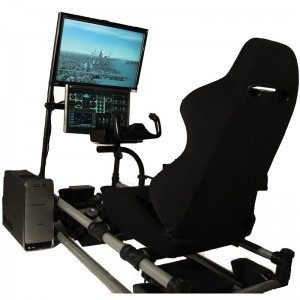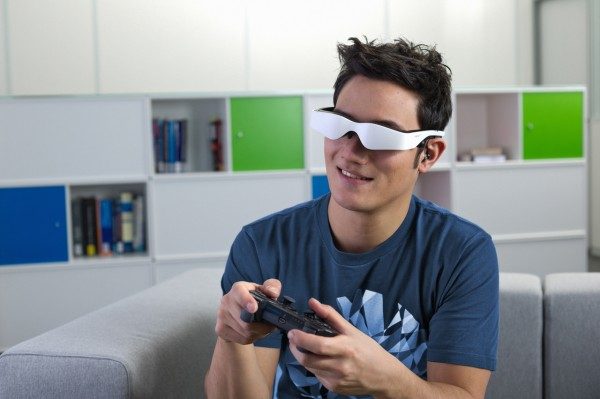 Virtual Reality is most likely an inevitable evolution in human-computer interaction—in the long term, anyway. But in the next 10 years, there’s a major risk of VR falling to the wayside as a novelty or an enthusiasts-only market. The closest analog I can think of is the flight-simulator market. There are enthusiasts out there who have amazing flight-simulator setups, but the list of supported games is relatively low, and the best hardware can be extremely expensive. Flight-simulators can be a whole lot of fun, but there’s never been full-fledged console support, and that has relegated flight-simulation to the PC gaming elite who have the money to buy not only top-end computers, but also top-end flight-simulation hardware.
Virtual Reality is most likely an inevitable evolution in human-computer interaction—in the long term, anyway. But in the next 10 years, there’s a major risk of VR falling to the wayside as a novelty or an enthusiasts-only market. The closest analog I can think of is the flight-simulator market. There are enthusiasts out there who have amazing flight-simulator setups, but the list of supported games is relatively low, and the best hardware can be extremely expensive. Flight-simulators can be a whole lot of fun, but there’s never been full-fledged console support, and that has relegated flight-simulation to the PC gaming elite who have the money to buy not only top-end computers, but also top-end flight-simulation hardware.
We’re at a fork right now with VR where, depending which way things go, it could take off into the mainstream, or become an expensive enthusiast/niche market.
Obviously I’d love to see the former; VR has amazing promise as a visceral medium that can connect with us on levels that were previously impossible. But what needs to happen for VR to really take off?
I’ve said it before and you’re about to hear it again—VR is ready. The technology is here. Someone just needs to put all of the pieces together. And that ‘someone’, I think, needs to be one of the major console manufacturers of our time. Namely, Sony, Microsoft, or Nintendo.
Before I start, I want to clarify what I mean by ‘VR’ in this article. Obviously there are many potential setups for virtual reality. In this article, when I say ‘VR’, I’m refering to, at very least, a head mounted display with head-tracking. Depending upon the game, a controller of some sort could still be used.
The Time is Right
 Companies like Sony and Silicon Micro Display are showing us that it’s quite possible to bring high definition, 3D capable, head mounted displays down to consumer-available price points. Right now we’re at the high end of the consumer-available price spectrum ($799), but this is significantly lower than similar HMDs that the military has purchased for somewhere in the $20,000 range! Let’s not forget that as the technology continues to develop and more companies enter the market, we’ll continue to see these prices drop to more affordable levels.
Companies like Sony and Silicon Micro Display are showing us that it’s quite possible to bring high definition, 3D capable, head mounted displays down to consumer-available price points. Right now we’re at the high end of the consumer-available price spectrum ($799), but this is significantly lower than similar HMDs that the military has purchased for somewhere in the $20,000 range! Let’s not forget that as the technology continues to develop and more companies enter the market, we’ll continue to see these prices drop to more affordable levels.
The big three console manufacturers have all shown their willingness to forgo the controller and experiment with unique motion control peripherals. Nintendo has the Wiimote, Microsoft has the Kinect, and Sony has the Move. This willingness think outside of the usual box is an important factor in getting one of these three to recognize VR as a practical and revolutionary way to interact with games.
A VR Gaming Console
 I’m not talking about a mere accessory. I’m talking about a new console that’s designed with VR specifically in mind—where the hardware is for VR and the games are made to provide immersive VR experiences.
I’m not talking about a mere accessory. I’m talking about a new console that’s designed with VR specifically in mind—where the hardware is for VR and the games are made to provide immersive VR experiences.
Sony is in a unique position right now to do this because they not only manufacture a very popular gaming console, but they also make an HMD, the HMZ-T1. The HMZ-T1 lacks native head tracking at the moment, but again, Sony is already invested in the technology. They just needs to whip together the full package—a new console that’s specifically designed to be the first VR console, packaged with an HMD.
I’ve sat by and watched as enthusiasts have cobbled together all of the various parts—all off-the-shelf and available today—to hack together rudimentary, but promising, VR setups. Every time I see this I can’t help but wonder: if these folks can put such a system together from off-the-shelf parts, with a few million in R&D one of the big three console makes could easily take VR mainstream.
Along with the support of a full console, the game medium will need to evolve to take full advantage of what VR can offer. Shoehorning VR into existing games can only take us so far—and that’s why I say we need the support of a full console release where, in the same way that all Xbox games made today are made with a controller in mind, all games for this hypothetical VR console would be made with VR in mind.
I’ve predicted that we will see the melding of games and movies into interactive experiences that will be able to connect with the audience at a much deeper level than the games of today. It needs to be recognized that VR is not just a different way to control the games we already play; it is an entirely new way to express games to players, and with that realization, we need entirely new games.
Unfortunately it seems that the next round of consoles won’t make their debut until 2014, and it seems unlikely that any of them will have any emphasis on VR… that means we’ll likely end up waiting another 8 years until the next console cycle where we would be much more likely to see a true VR console… and that puts us out to 2022. I don’t know if I’ll be satisfied waiting that long to see the implementation of technology that already exists today.
An Advocate
What we need is a VR advocate to really get things going. We need the people making the decisions to realize that everything needed for an interactive VR experience is here today. I honestly believe that if you took the top executives responsible for consoles from Microsoft, Sony, and Nintendo, and gave them a compelling VR demo, they would instantly recognize the potential of the technology. Just give them all an HMD with head tracking, have them take a stroll through Dear Esther, and they will be sold on the possibilities.
Hell, Nintendo’s existing Wii hardware is already capable of head-tracking and some VR-like functionality. They could easily take advantage of it, they just need to realize the potential that’s right under their noses!
More Than Just Games
Console makers will certainly not be investing in VR R&D with anything but profit in mind, but they should also realize that VR is far more than gaming. In the same way that Microsoft’s Kinect has made a big splash in various human-computer interaction and related fields, a mainstream VR system means so much more than better games. It means opening the doors to collaborative virtual work—architecture, performance, and more. It means virtual training—to immerse doctors, soldiers, construction workers and more, in complex scenarios so that they can be better prepared for real-world situations. It means a medium for rich interactive storytelling. And there’s so much more. Getting VR to the mainstream wouldn’t just be good for business, it will really transform the way we do things.






